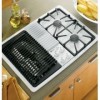GE JGP990WELWW Owners Manual - Page 32
LP Conversion Instructions
 |
View all GE JGP990WELWW manuals
Add to My Manuals
Save this manual to your list of manuals |
Page 32 highlights
LP Conversion Instructions 2 CONVERT SURFACE BURNERS 3 ADJUST GRILL BURNER AIR SHUTTER Turn clockwise to tighten Orifice Turn counterclockwise to remove A Remove all grates and burner modules. B With an adjustable wrench or an open end wrench, remove the brass orifices. C Find the inscribed LP orifices in the holder in the front of the electric cover beneath the cooktop. D Install the inscribed LP orifices in place of the natural gas orifices. E Replace the burner modules and grates. F Keep all the spuds with your cooktop so you have them if you move or get a different gas hook-up. LP (Propane) Gas 10″ W.C.P. Burner Output Rating in BTU/HR Location BTUs Orifice Size Engraving Left Rear (LR) 9,100 .0354 LP Left Front (LF) 9,100 .0354 LP Right Rear (RR) 9,100 .0354 LP Right Front (RF) 9,100 .0354 LP Air shutter Loosen screw Adjust air shutter opening Tighten screw The air shutters for the grill burner may need to be adjusted to get better flame appearance and ignition. The air shutters for the grill burner are located on the bottom of the grill burner. To access the air shutters, remove the grill grate, and then the grill burner. Loosen the screw and slide the air shutter backward or forward to increase or decrease the size of the air opening. Re-tighten the screw. 4 CHECK IGNITION A Connect electrical supply cord. B Turn on the gas; check for leaks using a liquid leak detector at all joints in the system. WARNING: DO NOT USE A FLAME TO CHECK FOR GAS LEAKS. Push in one control knob and turn to the LITE position. The igniter will spark and the burner will light. The first test may require some time while air is flushed out of the gas line. After ignition, turn the control knob to the HI position and wait until the flame settles. C Check to determine if your burner flames are normal. If burner flames look like A, turn off the burner and make sure all parts are assembled correctly. Reassemble and check. Normal burner flames should look like B or C, depending on the type of gas you use. With LP gas, some yellow tipping on outer cones is normal. A-Yellow flames Not normal; check alignments B-Yellow tips Normal for LP gas C-Soft blue flames Normal for natural gas D Turn the knob to OFF. E Repeat the procedure for each burner. 32















